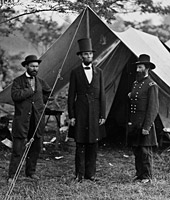A. Lincoln: A Biography
New Research, New Insights
By Les Steele, Professor of Christian Formation, Vice President for Academic Affairs

In October 1862, after the Civil War’s first battle on Northern soil at Antietam,
Maryland, Abraham Lincoln visits the troops in the field with Allan Pinkerton (left), head of Union Intelligence Services, and Major General John McClernand (right). |
In these days of texting and tweeting,
what is able to keep our attention
longer than five seconds? May I suggest
a biography of someone long dead that
has 676 pages of text and 115 pages
of notes and index?
A. Lincoln, a new biography of President Abraham Lincoln by Ronald C. White Jr., delivers disciplined scholarship and newly available information in a compelling story for the general reader. Beginning with Lincoln’s birth and ending with his assassination, White’s work immerses the reader in the personal and political life of one of our truly transformational leaders.
I began reading the book from a sense of duty but quickly found myself drawn to it by a sense of delight. If you’re like me, you’ll be captivated by the drama of Lincoln’s personal and national crises — and the strength and skill he displayed in facing them.
What makes this biography stand out among the many? White’s book has not only received outstanding reviews from other Lincoln scholars,
but it also presents brand new scholarship on Lincoln from the author’s own unique perspective. Since the last major biography on Lincoln in 1996, Lincoln’s legal papers and other letters and photographs not previously available have been released. Using this new material, White traces Lincoln’s evolving ideas.
For instance, White makes use of hundreds of notes jotted by Lincoln on scraps of paper. Many of these notes would find their way into Lincoln’s speeches and formal documents. The notes provide insights into his life, his work, and his thought about issues such as slavery, the Union, military strategy, and the sovereignty of God. They often included arguments both for and against a particular issue, showing that Lincoln considered multiple perspectives before his own position crystallized.
As in his previous books, White also carefully analyzes the language of Lincoln’s speeches, leading the reader to consider how Lincoln chose every phrase and word with great care. He illustrates how with one phrase, with one word, Lincoln could have chosen either to incite the listener to anger or to lead the listener to charity.
One of the most distinctive characteristics of this biography is that White carefully analyzes Lincoln’s developing religious thinking. While some scholars view Lincoln as disinterested in religion or even anti-religious, White reveals Lincoln’s growing and thoughtful faith in God. We read of
Lincoln the theologian, who is regularly visited by Christians from the North and South who declare that God is on their side. Lincoln writes many notes regarding these visits and the invigorating sermons of his pastor as he attempts to understand where God is in the midst of one of our nation’s darkest periods, the Civil War.
I found myself changed by this book, and for that I am grateful. I truly hope you find the same.
Return to top
Back to Features Home
|